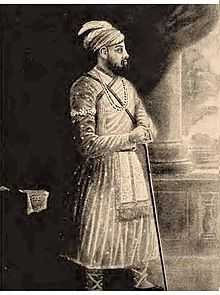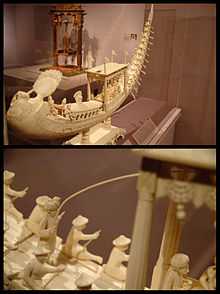Principality of Bengal
| Principality of Bengal | |||||
| Former Nation | |||||
| |||||
|
| |||||
 | |||||
| Capital | Murshidabad | ||||
| Languages | Persian (official), Bengali, Oriya, Arabic | ||||
| Religion | Islam, Hinduism, Buddhism, Christianity | ||||
| Government | Monarchy | ||||
| Nawab of Bengal, Bihar and Orissa | |||||
| - | 1717-1727 | Murshid Quli Khan (first) | |||
| - | 1756-1757 | Siraj-ud-Daulah (last) | |||
| Historical era | Early Modern | ||||
| - | Established | 1717 | |||
| - | Disestablished | 23 June 1757 | |||
The Principality of Bengal was an independent Mughal dominion ruled by the Nawabs of Bengal.[1] From their capital at Murshidabad, the Nawabs of presided over a large territory in the eastern Indian subcontinent, including Bengal, Northern Bihar and North-Eastern Orissa. The heartland of the state was in Bengal, which was India's most fertile and prosperous region.
History



Bengal is a region located in the low lying Ganges Delta. It was once ruled by a series of Hindu, Buddhist, and Islamic kingdoms before falling under the rule of growing Mughal Empire. A chain of subordinate officials, consisting of governors and Diwans, ruled Bengal till 1716. In 1717, Murshid Quli Khan emerged as the governor of Bengal. With his considerable influence over the Mughal Emperor, Aurangzeb, Khan had the Nazim, Azim-ush-Shan, moved to Bihar. With this, Murshid Quli Khan became the first Nawab Nazim of Bengal. He moved the capital to Murshidabad, a town named after him, and established the Principality of Bengal.
The Principality was ruled under 3 dynasties: Nasiri, Afshar, and Najafi. Murshid Quli Khan ruled from 1717 to 1727, when he was succeeded by his son in law, Shuja-ud-Din Muhammad Khan. After his death, in 1739, his son, Sarfaraz Khan, became the new Nawab. Sarfaraz, however, was killed during the Battle of Giria and was succeeded by Alivardi Khan, founder of the Afshar Dynasty. Alivardi Khan was considered to be a brilliant general and was able to establish peace with the Maratha Empire. After Khan, Siraj-ud-Daulah, his grandson, took power. The young and inexperienced Nawab was able to anger most people in his court and the British East India Company in Calcutta. In 1757, the forces of the Nawab and the Company confronted each other in the Battle of Plassey. Though the former's forces were much more powerful than those of the latter, the Nawab's head general, Mir Jafar, betrayed him and helped the British win. With this, the Principality was dissolved and the British took over control of Bengal while establishing Mir Jafar and the Najafi Dynasty as the puppet rulers of the region.
Nawabs of the Principality of Bengal The following is a list of all the Nawabs of Bengal while it was independent. Sarfaraz Khan and Mir Muhammed Jafar Ali Khan Bahadur (Mir Jafar) were the only Nawabs to become the Nawab twice (thought the latter was a puppet ruler).[2] The chronology started in 1717 with Murshid Quli Khan and ended in 1760 with the removal of Mir Jafar [3][4][2]
| Portrait | Titular Name | Personal Name | Birth | Reign | Death |
|---|---|---|---|---|---|
 |
Jaafar Khan Bahadur Nasiri | Murshid Quli Khan | 1665 | 1717– 1727 | 30 June 1727 |
 |
Ala-ud-Din Haidar Jang | Sarfaraz Khan Bahadur | ? | 1727-1727 | 29 April 1740 |
 |
Shuja ud-Daula | Shuja-ud-Din Muhammad Khan | Around 1670 (date not available) | July, 1727 – 26 August 1739 | 26 August 1739 |
 |
Ala-ud-Din Haidar Jang | Sarfaraz Khan Bahadur | ? | 13 March 1739 – April 1740 | 29 April 1740 |
 |
Hashim ud-Daula | Muhammad Alivardi Khan Bahadur | Before 10 May 1671 | 29 April 1740 – 9 April 1756 | 9 April 1756 |
 |
Siraj ud-Daulah | Muhammad Siraj-ud-Daulah | 1733 | April 1756 – 2 June 1757 | 2 July 1757 |
_and_Mir_Miran_(right).jpg) |
Ja'afar 'Ali Khan Bahadur | Mir Muhammed Jafar Ali Khan Bahadur | 1691 | June 1757 – October 1760 | 17 January 1765 |
Economy
Art and culture


References
- ↑ Farooqi, Salma Ahmed. (2011). A Comprehensive History of Medieval India. Chapter 30.
- ↑ 2.0 2.1 "The Nawabs of Bengal (chronologically)". Retrieved 28 July 2012.
- ↑ Murdhidabad.net (8 May 2012). "The Nawabs ruled earlier under the Mughal and later under the British". Retrieved 9 August 2012.
- ↑ Murshidabad.net (8 May 2012). "Decline of the Nawabs of Bengal". Retrieved 10 August 2012.
